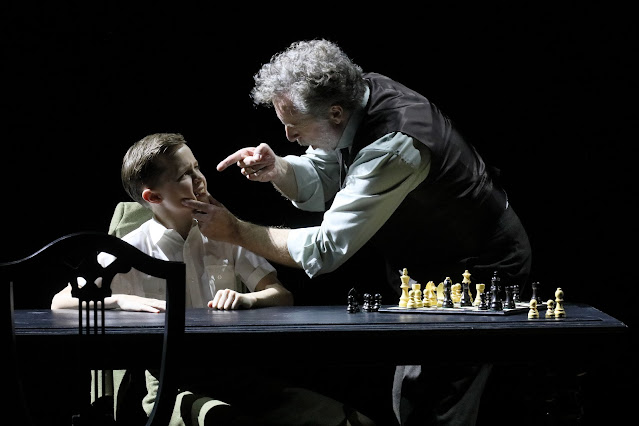Grosses Festspielhaus
Flamand – Sebastian Kohlhepp
Olivier – Konstantin Krimmel
La Roche – Mika Kares
Countess Madeleine – Elsa Dreisig
Count – Bo Skovhus
Clairon – Ève-Maud Hubeaux
Major-Domo – Torben Jürgens
Italian Soprano – Tuuli Takala
Italian Tenor – Josh Lovell
Servants – Kieran Carrel, Jonas Jud, Fabio Dorizzi, Ian Rucker, Christian Tschelebiew, Jan Petryka, Lucas van Lierop, Philipp Schöllhorn
Monsieur Taupe – Jörg Schneider
Vienna Philharmonic Orchestra
 |
| Images: © SF/Marco Borrelli |
There is a certain irony to the popularity of Capriccio in concert performance. The last time the Royal Opera presented Strauss’s valedictory opera – assuming we do not count Des Edels Schattens – it was also without staging. Now, for reasons unclear, it has appeared in the Salzburg Festival’s festival-within-a-festival of sacred music, ‘Ouverture Spirituelle’, treated as the first ‘full-scale’ opera of the festival, works by Georg Friedrich Haas and Luigi Dallapiccola notwithstanding, attracting the traditional complement of dignitaries for its premiere. Irony and Strauss are not so much excellent bedfellows as two sides of the same musical coin, so there is no problem there. If the world of La Roche found itself somewhat obscured on that occasion, the impresario inspired by Max Reinhardt remained present not only onstage, nodding off during the opening sextet, but also in honoured bust-form at the entrance to the Haus für Mozart next door. Strauss himself, naturally, remains on the first floor of the Grosse(s) Festspielhaus itself. And if a concert performance, perhaps especially without interval, may not have been entirely what some of those invited were expecting, they, like the rest of us, will surely have enjoyed finding themselves lightly satirised, elevated, and perhaps even inspired by what unfolded.
Interestingly, although no ‘concert director’ or similar was credited, a degree of accomplished acting was involved, as were telling transformations in lighting (not least for the closing moonlight). Truth be told, or at least one truth among many, little seemed to be lost. When the cast engaged so animatedly with one another, onstage when necessary and offstage when not, the impression was not so very different from a ‘traditional’ production in which they would do the very same, only seated in an eighteenth-century salon. And Strauss’s question, Countess Madeleine’s too, is ultimately ‘Wort oder Ton?’ not ‘words, music, or gesture,’ however strangely that sits both with the conversations and the composer’s veneration for Wagner’s Opera and Drama (‘the book of books about music’). If we all ultimately know which will win in our hearts and minds, if not necessarily in the Countess’s, then the contest was established with commendable even-handedness by those performing, balances of all kind upheld and dramatically generative, even without a mise-en-scène or directorial Konzept.
Moreover, if one might expect the conductor, possibly the orchestra too, to be favoured in such a scenario, such was not the case. Christian Thielemann has often proved to be at his best in Strauss. He led an extraordinary performance of Die Frau ohne Schatten in this same hall thirteen years ago, blighted yet far from obliterated by Christof Loy’s arrogant dismissal of the work as director; the composer has long proved central to his operatic work in Dresden, Vienna, and elsewhere. If his Dresden FroSch earlier this year was impressive yet, to my mind, a little on the precious side, this Capriccio unfolded with a warmth, affection, and ease that spoke of a fine balance – that word again – between preparation and familiarity. Restraint is not quite the word, but there was no grandstanding, nothing forced. One was led to listen, perhaps via music, yet to words as much as their confrere-competitors. Quotations were assumed into the orchestral fabric, never underlined. That might be the vulgar way of some, but hardly Strauss’s. There were passages of rapt orchestral magic; if the close of the string sextet has sounded more hushed, I have not heard it so. The Vienna Philharmonic clearly loves playing for Thielemann; it is just as clear that the affection is mutual. And although that sextet was certainly conducted, it never sounded like it.
Sebastian Kohlhepp and Konstantin Krimmel made for a pair of finely cast, nicely contrasted suitors as Flamand and Olivier respectively. If Flamand ultimately stole the heart, that is really Strauss’s doing. Mika Kares lived up to La Roche’s outsize promises in a performance that relished not only his boastfulness but also his status as dramatic lynchpin, leaving implicit sadness – or am I being sentimental? – to another day. Ève-Maud Hubeaux was a splendid Clairon; before I knew who she was, I truly sensed the ‘act’ of a French tragedienne. Such is not reserved to a French singer, of course, but there was a tang of almost Voltairean authenticity here, without sacrifice to crystal-clear German. Bo Skovhus marshalled his resources wisely as the Count. Torben Jürgens’s Major-Domo made a fine impression, as did an array of individual servants, perhaps the best I have heard. They might have had a spin-off show of their own; perhaps one day they will.
One person is missing in that, of course, and it was there that I found
myself, seemingly unlike the audience, somewhat in two minds. Elsa Dreisig’s
Countess was well sung, well acted, in general had much to commend it, yet somehow
did not feel quite ‘right’ to me. Was that a matter of having too much a
certain interpretation or mode of interpretation in my head, to which others
must conform? Quite possibly, but what I heard came across in tone and
character as more girlish, even Sophie-like, than a successor to the
Marschallin, the true director of metatheatrical proceedings. I shall dwell on
this no more; we all have our preconceptions and prejudices, and this may well
have been mine. As we all know, no operatic performance is or can be perfect,
let alone correct. Music, words, and theatre (visible or invisible) are too human
for that.
.jpg)




















_Festival%20d'Aix-en-Provence%202024_%C2%A9%20Monika%20Rittershaus_8.jpg)
_Festival%20d'Aix-en-Provence%202024_%C2%A9%20Monika%20Rittershaus_8.jpg)





